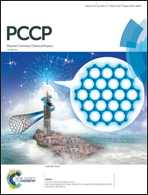Modeling excitation energy transfer in multi-BODIPY architectures†
Abstract
The excitation energy transfer (EET) allowing the concentration of the energy has been investigated in several multi-BODIPY architectures with the help of an approach coupling time dependent density functional theory to an implicit solvation scheme, the polarizable continuum model. We have first considered several strategies to compute the electronic coupling in a dyad varying the size of the donor/acceptor units, the bridge, the geometries and conformations. We have next studied the electronic coupling in three different architectures for which the EET rate constants have been experimentally measured both from luminescence and transient absorption data and from Förster theory. A good agreement with experimental values was obtained. Finally, in an effort to further improve these systems, we have designed several series of BODIPY triads, investigating the effect of acidochromism, core modifications, the position of the linkage and chemical substitutions on the EET coupling and rate constant. We show that several architectures allow us to increase the EET rate by one order of magnitude compared to the original compound.



 Please wait while we load your content...
Please wait while we load your content...